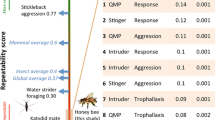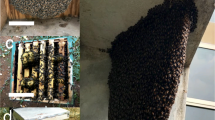Abstract
Metabolic rate is often cited as the fundamental rate which determines the rate of all biological processes by shaping energetic availability for the various physiological, behavioral, and life-history traits that contribute to performance. It has therefore been suggested that metabolic rate drives the widely observed covariance among these different levels of phenotypic traits. However, much of the work on this topic has relied on pairwise correlational analysis on a handful of traits at a time, leaving an important gap in our understanding regarding the functional links that shape this phenotypic covariance, often referred to as pace of life. Using honeybees as a model, we measured a large number of behavioral, life-history, and physiological traits in individual bees and used a path analysis to demonstrate that variation in metabolic rate plays a fundamental proximate role in driving the covariance among these traits. We combined this with a factor analysis in a structural equation model framework to characterize the overall phenotypic covariance or the pace-of-life axis in honeybees. We discuss the importance of these findings in the context of how interindividual variation in terms of slow–fast phenotypes may drive the phenotype of a group and the functional role metabolic rate might play in shaping division of labor and social evolution.
Significance statement
The study provides empirical support for the theoretical idea that metabolic rate acts as a proximate driver of phenotypic covariance among several physiological, behavioral, and life-history traits at the individual level and that behavior acts as a mediator for how metabolic rate affects life history. In addition, using honeybees as an experimental model for this study establishes a framework for asking questions regarding how these individual-level phenotypic covariance patterns lead to observed phenotypic covariance patterns at the colony level, an idea which has functional consequences for division of labor and social evolution. The results of this study therefore contribute toward a better understanding of the rules of life that shape processes across different levels of biological organization. Our use of different structural equation modeling approaches for inferring heuristics and proximate causal relationships among multiple phenotypic traits also informs future research efforts on this topic.




Similar content being viewed by others
Data availability
Data can be accessed via the Dryad Digital Repository https://doi.org/10.5061/dryad.n8pk0p2rz
References
Amdam GV, Rueppell O, Fondrk MK, Page RE, Nelson CM (2009) The nurse’s load: early-life exposure to brood-rearing affects behavior and lifespan in honey bees (Apis mellifera). Exp Gerontol 44:467–471
Arnqvist G, Stojković B, Rönn JL, Immonen E (2017) The pace-of-life: a sex-specific link between metabolic rate and life history in bean beetles. Funct Ecol 31:2299–2309
Bengston SE, Shin M, Dornhaus A (2017) Life-history strategy and behavioural type: risk-tolerance reflects growth rate and energy allocation in ant colonies. Oikos 126:556–564
Biro PA, Stamps JA (2008) Are animal personality traits linked to life-history productivity? Trends Ecol Evol 23:361–368
Biro PA, Stamps JA (2010) Do consistent individual differences in metabolic rate promote consistent individual differences in behaviour? Trends Ecol Evol 25:653–659
Blight O, Albet DG, Cerdá X, Boulay R (2016) A proactive–reactive syndrome affects group success in an ant species. Behav Ecol 27:118–125
Brown JH, Gillooly JF, Allen AP, Savage VM, West GB (2004) Toward a metabolic theory of ecology. Ecology 85:1771–1789
Careau V, Garland T Jr (2012) Performance, personality, and energetics: correlation, causation, and mechanism. Physiol Biochem Zool 85:543–571
Careau V, Thomas D, Humphries MM, Réale D (2008) Energy metabolism and animal personality. Oikos 117:641–653
Dammhahn M, Dingemanse NJ, Niemelä PT, Réale D (2018) Pace-of-life syndromes: a framework for the adaptive integration of behaviour, physiology and life history. Behav Ecol Sociobiol 72:62
Debecker S, Stoks R (2019) Pace of life syndrome under warming and pollution: integrating life history, behavior, and physiology across latitudes. Ecol Monogr 89:e01332
Dukas R (2008) Mortality rates of honey bees in the wild. Insect Soc 55:252–255
Feuerbacher E, Fewell JH, Roberts SP, Smith EF, Harrison JF (2003) Effects of load type (pollen or nectar) and load mass on hovering metabolic rate and mechanical power output in the honey bee Apis mellifera. J Exp Biol 206:1855–1865
Glazier DS (2015) Is metabolic rate a universal ‘pacemaker’ for biological processes? Biol Rev 90:377–407
Goulet CT, Thompson MB, Michelangeli M, Wong BBM, Chapple DG (2017) Thermal physiology: a new dimension of the pace-of-life syndrome. J Anim Ecol 86:1269–1280
Harrison JF, Fewell JH (2002) Environmental and genetic influences on flight metabolic rate in the honey bee, Apis mellifera. Comp Biochem Physiol A 133:323–333
Jablonszky M, Szász E, Krenhardt K, Markó G, Hegyi G, Herényi M, Laczi M, Nagy G, Rosivall B, Szöllósi E, Török J, Garamszegi LZ (2018) Unravelling the relationships between life history, behaviour and condition under the pace-of-life syndromes hypothesis using long-term data from a wild bird. Behav Ecol Sociobiol 72:52
Jeanson R, Weidenmüller A (2014) Interindividual variability in social insects–proximate causes and ultimate consequences. Biol Rev 89:671–687
Katz K, Naug D (2015) Energetic state regulates the exploration–exploitation trade-off in honeybees. Behav Ecol 26:1045–1050
Katz K, Naug D (2020) A mechanistic model of how metabolic rate can interact with resource environment to influence foraging success and lifespan. Ecol Model 416:108899
Krams I, Niemelä PT, Trakimas G, Krams R, Burghardt GM, Krama T, Kuusik A, Mänd M, Rantala MJ, Mänd R, Kekäläinen J, Sirkka I, Luoto S, Kortet R (2017) Metabolic rate associated with, but does not generate covariation between, behaviours in western stutter-trilling crickets, Gryllus integer. Proc R Soc B 284:1851
Masoro EJ (2005) Overview of caloric restriction and ageing. Mech Ageing Dev 126:913–922
Mathot KJ, Frankenhuis WE (2018) Models of pace-of-life syndromes (POLS): a systematic review. Behav Ecol Sociobiol 72:41
Mayack C, Naug D (2011) A changing but not an absolute energy budget dictates risk-sensitive behaviour in the honeybee. Anim Behav 82:595–600
Nilsson JA (2002) Metabolic consequences of hard work. Proc R Soc B 269:1735–1739
Page RE, Erber J, Fondrk MK (1998) The effect of genotype on response thresholds to sucrose and foraging behavior of honey bees (Apis mellifera L.). J Comp Physiol A 182:489–500
Page RE, Scheiner R, Erber J, Amdam GV, Gerald PS (2006) The development and evolution of division of labor and foraging specialization in a social insect (Apis mellifera L.). Curr Top Dev Biol 74:253–286
Pankiw T, Page RE (2000) Response thresholds to sucrose predicts foraging division of labor in honeybees. Behav Ecol Sociobiol 47:265–267
Réale D, Garant D, Humphries MM, Bergeron P, Careau V, Montiglio PO (2010) Personality and the emergence of the pace-of-life syndrome concept at the population level. Philos Trans R Soc B 365:4051–4063
Ricklefs RE, Wikelski M (2002) The physiology/life-history nexus. Trends Ecol Evol 17:462–468
Robinson GE (1992) Regulation of division of labor in insect societies. Annu Rev Entomol 37:637–665
Rosseel Y (2012) lavaan: an R package for structural equation modeling. J Stat Softw 48:2
Royauté R, Berdal MA, Garrison CR, Dochtermann NA (2018) Paceless life? A meta-analysis of the pace-of-life syndrome hypothesis. Behav Ecol Sociobiol 72:64
Rueppell O, Bachelier C, Fondrk MK, Page RE (2007) Regulation of life history determines lifespan of worker honey bees (Apis mellifera L.). Exp Gerontol 42:1020–1032
Santostefano F, Wilson AJ, Niemelä PT, Dingemanse NJ (2017) Behavioural mediators of genetic life-history trade-offs: a test of the pace-of-life syndrome hypothesis in field crickets. Proc R Soc B 284:20171567
Scheiner R, Plückhahn S, Öney B, Blenau W, Erber J (2002) Behavioural pharmacology of octopamine, tyramine and dopamine in honey bees. Behav Brain Res 136:545–553
Segev U, Burkert L, Feldmeyer B, Foitzik S (2017) Pace-of-life in a social insect: behavioral syndromes in ants shift along a climatic gradient. Behav Ecol 28:1149–1159
Sinclair DA (2005) Toward a unified theory of caloric restriction and longevity regulation. Mech Ageing Dev 126:987–1002
Sohal RS, Weindruch R (1996) Oxidative stress, caloric restriction, and aging. Science 273:59–63
Sullivan JP, Jassim O, Fahrbach SE, Robinson GE (2000) Juvenile hormone paces behavioral development in the adult worker honey bee. Horm Behav 37:1–14
Wagener-Hulme C, Kuehn JC, Schulz DJ, Robinson GE (1999) Biogenic amines and division of labor in honey bee colonies. J Comp Physiol A 184:471–479
Wilson EO (1987) Causes of ecological success: the case of the ants. J Anim Ecol 56:1–9
Wray MK, Mattila HR, Seeley TD (2011) Collective personalities in honeybee colonies are linked to colony fitness. Anim Behav 81:559–568
Acknowledgments
The authors would like to thank Maybellene Gamboa for her help with respirometry, Catherine Tait, John Starinieri, and Amy Zimmermann for their help with data collection, and three anonymous referees for their insightful comments.
Funding
This study was funded by grants from the National Science Foundation and Foundation for Food and Agricultural Research to DN.
Author information
Authors and Affiliations
Contributions
SGM and DN designed the study and wrote the manuscript. SGM collected and analyzed the data.
Corresponding author
Ethics declarations
Conflict of interest
The authors declare that they have no conflicts of interest.
Code availability
NA
Additional information
Communicated by A. Toth
Publisher’s note
Springer Nature remains neutral with regard to jurisdictional claims in published maps and institutional affiliations.
Electronic supplementary material
ESM 1
(DOCX 5332 kb)
Rights and permissions
About this article
Cite this article
Mugel, S.G., Naug, D. Metabolic rate shapes phenotypic covariance among physiological, behavioral, and life-history traits in honeybees. Behav Ecol Sociobiol 74, 129 (2020). https://doi.org/10.1007/s00265-020-02901-5
Received:
Revised:
Accepted:
Published:
DOI: https://doi.org/10.1007/s00265-020-02901-5




